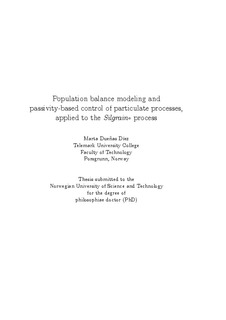| dc.description.abstract | This thesis deals with the systematic development of mechanistic models of particulate processes for the purposes of nonlinear controller design and implementation.The methods investigated in this thesis were illustrated with an industrial hydrometallurgical process called the Silgrain® process (Elkem ASA), for which a model and a controller strategy have been developed from scratch.
The class of processes studied in this thesis, particulate processes,has attracted and still attracts a great deal of interest from the international research community. Particulate processes are characterized by the presence of a continuous phase and a dispersed phase comprised of entities that have a distribution of properties. Such a distribution of properties has an important impact on the process operation and quality of the final products. Moreover, most of process industries contain one or more stages that involve particulate processes, among them the major Norwegian companies: Elkem, Hydro, Borealis, Statoil, etc.
A systematic method to PBE modeling was suggested, consisting of the following stages: establishment of model purpose and model foundations, building of the model structure, determination of the constitutive relations, selection of a solution method, parameter estimation and model validation. Such an approach is general to any type of process, but when dealing with particulate processes special care should be placed on some of these stages. The method was thoroughly illustrated with the development of the model of the tworeactors of the Silgrain® process. The model was based on the traditional balance equations of mass, energy, and momentum, and on a balance of the distribution of properties, called the population balance equation (PBE). This is the first time PBE is used to model a hydrometallurgical leaching reactor where disintegration takes place. An experimental laboratory campaign had to be carried out in order to determine the constitutive equations of the disintegration event. Another experimental campaign at the plant level was carried out to gather data for parameter estimation and model validation. The results of the fitting were satisfactory. Besides the particular contribution of developing a detailed model for the case study, some general contributions of this research were:
• it was shown how dividing the model into compartments according to the regions that are observed in practice in the reactors is key to obtaining realistic models;
• it was discussed how the widely used assumption of complete mixing provides unrealistic models. Instead, the compartmentalization approach combined with a balance of forces on the entities to define the interflows among compartments improves the realism of PBE models to a great extent;
• it was shown that the use of a systematic parameter identifiability analysis prior to parameter estimation can be very useful, and even essential. PBE models are large in size, typically nonlinear in the parameters, and many parameters may not be identifiable from theavailable measurements. Hence, if no parameter identifiability analysis is carried out, the parameter estimation algorithm may break down, or give very poor parameter estimates.
An approach to process control called inventory passivity-based control was selected in this thesis, since this method handles nonlinear processes, is based on dynamic models, and it has suitable stability properties. In order to apply this method to particulate processes, the theory was extended in this thesis to handle rectangular systems, i.e. systems where the number of available manipulated variables is less than the number of inventories. Both chemical reaction networks and particulate processes fall under such a class of systems. An stability proof has been developed, by linking inventory passivity-based control to a relevant theory of nonlinear chemical dynamics, called the Feinberg Deficiency Theorems. In addition to stability, some other implementation issues were discussed in the thesis, such as the handling of constraints on the manipulated variables, the robustness of the controller against disturbances and model errors, the importance of observers, and the adaptation of the approach to semibatch control. Finally, the thesis also discussed the role of inventory passivity-based control within the framework of plantwide control, and the integration of inventory passivity-based control with a statistical process monitoring approach. | nb_NO |
